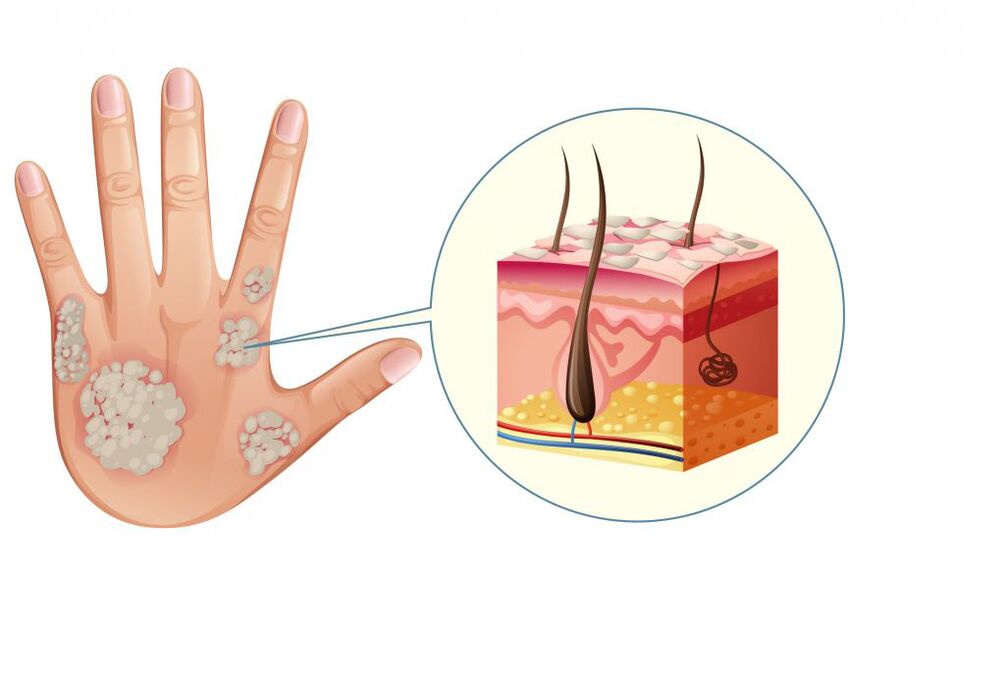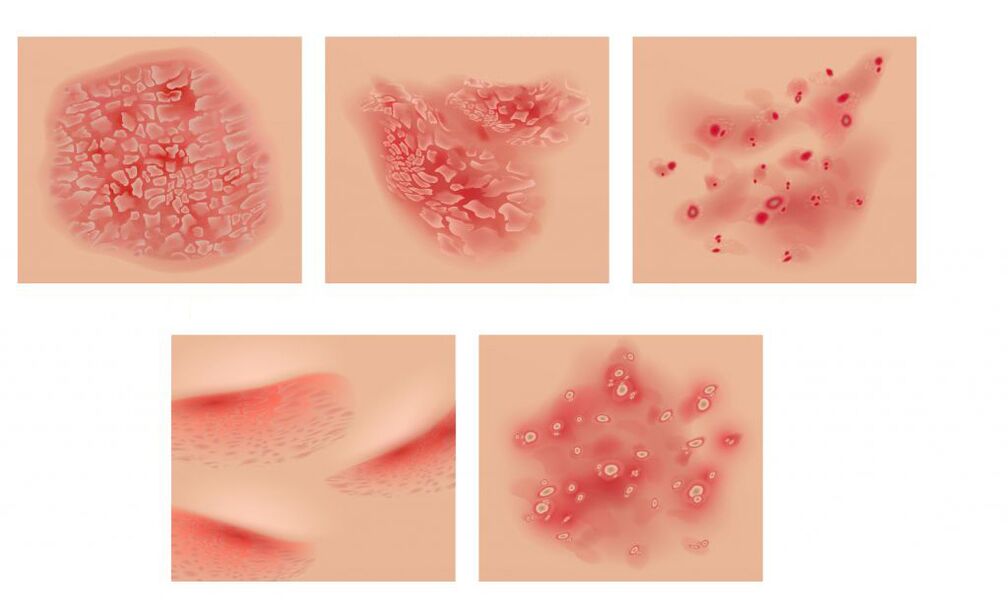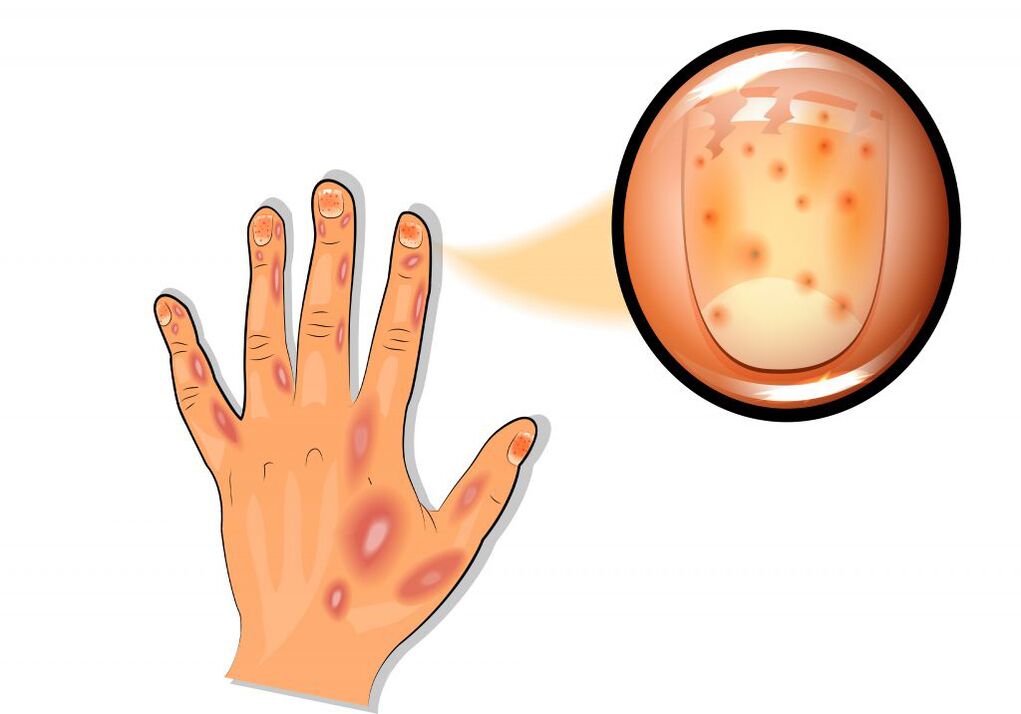Psoriasis: causes, symptoms, diagnosis and treatment.
Psoriasis is a chronic, non-communicable disease that can affect different organs: skin, joints, heart, kidneys.
Typically, mild psoriasis appears on the skin as clear pinkish-red papules (nodules raised above the skin's surface) that coalesce into silvery-white scaly patches.
In moderate and severe disease, the inflammatory process leads to damage to the musculoskeletal system and the cardiovascular system. Psoriasis has a relapsing course (recurrence of symptoms after complete or partial recovery) and tends to cause comorbidities that reduce the patient's quality of life.
Causes of Psoriasis
The disease can be based on a number of triggers. However, it is still not known exactly which is primary and which is secondary. The impaired function of the immune system is considered to be the leading cause of the occurrence of psoriasis. Cells aimed at destroying pathogens begin to attack their own cells (mainly the skin). As a result, an inflammatory process develops, which accelerates the cell division of the epidermis (epidermal hyperplasia) and the formation of papules and psoriatic plaques.

An inadequate immune response is usually due to genetic predisposition.
Psoriasis is very often inherited.
Currently, more than 40 chromosomal regions have been identified that are associated with the risk of developing psoriasis. The onset of the disease can be due to a weakening of the immune system against the background of stress, infectious diseases, endocrine. Psoriasis is often accompanied by allergic and immunodeficiency conditions, which are based on a violation of the immune response. In addition, psoriasis can be triggered by certain medications (antidepressants, beta-blockers, non-steroidal anti-inflammatory drugs).
Classification of psoriasis
Depending on the localization of the pathological process, different types of psoriasis are distinguished. The most common is vulgarity, orcommon, psoriasiswhen on the skin appear pink papules with clear limits, coalescing into patches covered with silvery white scales. In case of scalp damage (seborrheic psoriasis) a rash in the form of yellow scabs that may run down the forehead, forming a sebaceous "crown". In patients with metabolic disorders, plaques may appear exudative, a fluid secreted during inflammation (exudative psoriasis). In childhood and adolescence, especially after a streptococcal infection, the disease can become acute, with multiple bright red teardrop-shaped papules appearing on the skin with peeling and mild infiltration (guttate psoriasis). Sometimes pustular psoriasis, characterized by the appearance of pustules on a red background, usually occurs on the arches of the feet or palms.Erythema psoriaticmay occur against the background of exacerbations of ordinary psoriasis under the influence of provoking factors. Dry white flakes cover the skin, bright red, swollen and hot to the touch. Running is hardGeneralized Zumbusch psoriasis. It is characterized by the fact that small pus-filled blisters appear on the reddened skin, which merge to form a "purulent lake".Psoriatic arthritisaccompanied by damage to the joints and develop concurrently with a rash or a rash preceding them.

Symptoms of Psoriasis
The cutaneous form of psoriasis is accompanied by the appearance of bright pink punctate papules, sometimes in the form of drops. Fusing, they form patches covered with silvery-white scales.
The rash is located on the extensor surfaces of the arms and knees, on the scalp, lower back, and sacrum.
The top layer of atheroma formed by the scaly layer of dead epidermis is easily removed. Initially, they occupy the center of the plaque, and then fill its entire area. When the scab is removed, a bright red shiny surface is revealed. Sometimes the plaque is surrounded by a pink rim - an area that continues to grow, while the surrounding skin remains unchanged. Rash accompanied by intense itching. With erythrodermic psoriasis, the patient develops fever (fever accompanied by chills) and intense itching with a background of a generalized rash, and enlarged lymph nodes.
With a long period of the disease, hair and nails can fall out.
Generalized Zumbusch psoriasis is very difficult. Purulent blisters cover the entire skin and are accompanied by severe fever and intoxication. Psoriatic joint damage is characterized by pain and redness of the skin on the joint surface. Any movement is difficult, inflammation of the ligaments and tendons develops. With psoriasis, the nail plates are very often affected, while precise indentations appear on the nail surface (a "shaking" symptom).

Small red-brown and yellow-brown spots appear under the nail plate at the base (symptoms of "oil spots"). Dystrophic changes in the nails and hair often develop.
In children, especially infants, the symptoms of psoriasis are unique.
In the area of red skin, there may be effusion and slight peeling of the upper layer of the epidermis. This looks like a diaper rash or candidiasis. Sometimes the rash appears on the skin of the face or in the genital area.
Diagnosis of psoriasis
The disease can be identified on the basis of symptoms of the triad of psoriasis (white papule; red glossy film after scabbing and protrusion of blood after excision).
An additional feature is the Koebner phenomenon. It is located where, in the irritated skin, after 7-12 days will appear scaly erythematous nodules (area of skin that is scratched, red, and peeling). Sometimes, to confirm the diagnosis, a biopsy of the affected skin is performed. In addition, clinical examination and laboratory tests are required: clinical blood tests, blood biochemical tests (total protein, fractional protein, C-reactive protein, ALT, AST, LDH, creatinine, electrolytes: potassium). , sodium, chlorine, calcium).
Which doctor to contact?
If a rash appears, which often occurs against the background of an infectious disease, skin injury, stress, you should consult a therapist or a dermatologist. In the case of systemic damage to the patient's body, they may be referred to an ophthalmologist, endocrinologist, gynecologist or other specialist.
Treatment
Psoriasis affects both the skin and the musculoskeletal system, as well as the internal organs. When the rash appears only on the skin, local glucocorticosteroids, ointments containing synthetic analogues of vitamin D3, activated zinc, salicylic acid and other ingredients are recommended. Care should be taken when using hormonal creams on areas prone to atrophy.
The possibility of hormonal disturbances should be taken into account with prolonged use of steroid creams.
The effectiveness of hormonal creams is increased when combined with salicylic acid, analogues of vitamin D. For the treatment of severe forms of psoriasis, second-generation aromatic retinoids, based on acitretin, are prescribed. use. The drug slows down the proliferation of epidermal cells, normalizes keratinization and has an immunomodulatory effect. Phototherapy (UV therapy and medium-wave PUVA) in combination with a retinoid is also recommended. As a systemic therapy, your doctor may prescribe immunosuppressive drugs. If necessary, prescribe antidote and desensitization therapy, electrophoresis.
Complications of psoriasis
In 10% of patients, psoriatic arthritis develops, affecting the spine, joints, and legs. The patient has joint pain and stiffness in the morning. Features of psoriatic arthritis include asymmetry of its sites of manifestation, which may be associated with nail lesions. Psoriasis is often accompanied by comorbidities or comorbidities.
Inflammatory blood vessel damage increases the risk of coronary heart disease and stroke.
It is also possible to develop diabetes and Crohn's disease. In some cases, complications from psoriasis can lead to disability.
Psoriasis prevention
Psoriasis preventive measures are mainly aimed at strengthening the immune system. Skin care should include hydration and nutrition. With an allergy prone body, it is necessary to control the diet, avoid eating greasy and spicy foods, eating too much starch, potatoes. An imperative component of psoriasis prevention should be vitamin therapy.
In addition, the functioning of the immune system largely depends on the state of the nervous system. People with high responsibilities, busy work schedules, and frequent negative psycho-emotional effects are more susceptible to autoimmune diseases, including psoriasis. Therefore, the prevention of psoriasis, along with physical remedies (abandoning bad habits, being physically active), also needs to create psycho-emotional comfort.
IMPORTANT!
The information in this section should not be used for self-diagnosis or self-treatment. In the case of pain or other exacerbations of the disease, only the attending physician should prescribe diagnostic tests. For proper diagnosis and treatment, you should contact your doctor.

























